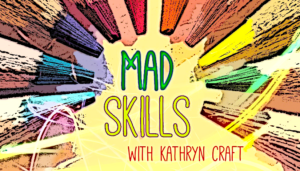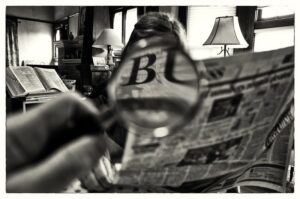Process
We’re thrilled to have returning guest Danielle Davis on Writer Unboxed today! Danielle has had dark fantasy and horror published in Andromeda Spaceways Magazine, The Astounding Outpost, and multiple anthologies. You can find her on most social media under the handle “LiteraryEllyMay” and at her website, literaryellymay.com
It’s Not Me, It’s the Story
Have you ever reached a point where you couldn’t see the path forward while writing your story, and found yourself saying, “What is wrong with me?” It’s an easy trap to fall into, to see our stories as a projection of ourselves and to equate our story’s perceived value with an internal sense of worth. We put so much of ourselves into our writing that it’s a natural tendency to create an inflated sense of connection between the two and to take it personally when the story doesn’t want to work the way we want it to. This, in turn, drains motivation and makes it hard to move past those negative feelings.
In her TED Talk, “Teach Girls Bravery, Not Perfection,” Reshma Saujani provides the anecdote of a friend who is an instructor at the University of Columbia. During office hours with his computer science students, he noted that men struggling with an assignment would say, “Professor, there’s something wrong with my code.” But when the women came in, they said, “Professor, there’s something wrong with me.”
This resonated with me. I, too, struggle with the culture that Saujani coins “perfection or bust” when I’m working on a story. I often beat myself up about not being further along as an author or tell myself that it’s a personal failing on my part. I tell myself that mine are pipe dreams and I’m just not cut out for this work. It’s a pervasive thought, that you aren’t enough, and if you’re not careful, it can fester and grow into a writer’s block that sticks.
Not too long ago, after wrestling with a sudden dead-end in my WIP, I went to my husband and lamented, “It’s not working out. I think I’m just not the writer for this story.” He very quickly (and correctly) called me out about it. Talking with him made me realize that it wasn’t ME. I wasn’t the failure. Elements in my story needed to be improved. A few tears and several days later, I realized what wasn’t working and made the necessary corrections. And it began to move again.
In the process, I began to identify several ways to fight that sense of personal failure and inadequacy:
Read More
Writing is like driving at night in the fog. You can only see as far as your headlights, but you can make the whole trip that way. ~ EL Doctorow
Have you ever felt like you had to be a plotter or outliner to be a “real” or successful writer, or to get traditionally published?
Conferences, bookstore shelves, and MFA programs are filled with advice on how to plot a book. One could forgive a new—or not so new—writer for thinking that plotting is the “right way,” maybe the only way, to write. TL;DR: It’s not.
Have you tried all of the methods and then wondered what was wrong with you when they didn’t work? I have.
It honestly shocked me that I can’t plot. (Or rather, I can, but it never survives past the first scene, and that’s weeks of writing time I can’t get back.) I’m a planner, a list-maker, a scheduler, and someone who made a career of process improvement. I’ve happily sat through every plotting workshop and read dozens of plotting books, trying to figure out how to streamline my process.
But after more than a decade of looking for a system that works for me, I finally realized I already had one. I used it when I wrote my first three manuscripts, before I knew anything about writing, I used it for my six published books, and I’m using it on my current manuscript.
It’s my natural process, and it’s messy and slow and challenging and exciting and adventurous, and nothing like the “best practices” and “shoulds” that regularly get hammered into our brains.
Think about some of those “rules of writing” that everyone knows you have to follow. Think especially of those that make you feel guilty or stupid or never seem to work for you. How many times have you been made to feel lazy because you don’t want to plot?
This isn’t a discipline or focus issue. It’s a difference in process.
There Are Many Ways to Plot
With the exception of Steven James’s Story Trumps Structure, I know of very few books that are explicitly about writing without figuring out the story in advance. Everyone seems to have a slightly different method to teach, but since they’re all plotters, it can feel like you have to be too. I promise, you don’t.
The fact that there are so many plotting systems seems to prove that everyone is wired differently and that there’s no One Right Way.
Is plotting easier? Maybe.
If you’re a plotter.
I’m not here to tell you not to plot. I’m just here to tell you that it’s okay if you don’t.
In fact, I’d argue that pantsers (a.k.a. seat-of-the-pants/discovery/into-the-mist writers) do plot. But instead of creating an 80-page outline, we get even more detailed and write an entire first draft in order to work out the story. 😉
Is Plotting Really Faster?
There’s this idea that writing is like taking a trip. You start with a destination in mind, you calculate that 300 miles a day will get you there in 3 days, you plan out your route on a map, and follow it for 900 miles. Done.
I love the metaphor, but for it to work for me, it’d have to be more like this:
Read More
Please welcome author-in-progress Kristina Stevens to Writer Unboxed today! We were approached by WU contributor Jim Dempsey about Kristina’s journey, which has involved writing a novel that began as a memoir. How did she decide on that change? What did that change entail? And would we be interested in sharing the journey (yes!).
More about Kristina from her bio:
You can learn more about Kristina by following her on Twitter @kriss_outsider.
How Do You Adapt Real Life Into Fiction?
“All this happened, more or less.”
This is the opening line to Kurt Vonnegut’s Slaughterhouse-Five. The novel is a semi-autobiographical account of the bombing of Dresden by the Allied Forces in 1945. Anyone familiar with Slaughterhouse-Five, however, would struggle to define it as realistic or true to life. The novel contains time travel and alien abduction, not things that you would believe “happened, more or less.”
So although we can safely say that Slaughterhouse-Five is not a factual account of the author’s experience of war, it does contain truth, or rather Truth. Slaughterhouse-Five disrupts the traditional structure of the novel, and the often chaotic form of the chapters reflects Billy Pilgrim’s frame of mind, his trauma resulting from the Dresden air raids. The narrative is non-linear and scenes describing the bombing can present as incoherent. This confusion and futility is the ultimate metaphor of war and its horror.
Memoir or Fiction?
When I started writing, I wasn’t sure if I should write in the form of memoir or fiction, but I settled on memoir. I believed memoir would have the most impact as there nothing more powerful than literal truth. In this world of “fake news” and spin, I felt that to tell my story I had to be painfully honest and adhere doggedly to fact. However, through the process of writing, I have learned that honesty and truth can be conveyed sometimes more effectively and potently through storytelling and metaphor.
You might have noticed that I called my writing ‘my story’, but that changed as the story itself became more important than my place or ego within that. Memoir is by its nature an account of an experience or experiences as interpreted by the author. However, the more I wrote, the more I felt myself being pushed out the story. I wasn’t at the centre of it, rather it was developing its own volition. I thought I was writing about specific themes and ideas, but I began to see that the story was asking its own question: Where do I belong?
I realised that question was central to everything and had to be explored; it was the essence of what I was trying to say. The day-to-day factually correct record of events and conversations became unimportant, even irrelevant. As I started to write, this concept of ‘Where do I belong’ began to grow more powerful, and I knew that in order […]
Read Morephoto adapted / Horia Varlan
We were good students, most of us. At the very least we loved reading and writing, and if our interest flagged in other subjects, we were either daydreaming or reading novels hidden beneath our desks.
Complete sentences were our currency. We never started one with a cheap conjunction like “and” or “but,” or ended one with a preposition like “with” or “to.” Each paragraph featured a topic sentence supported by subsequent points.
A truly creative writer knew several dozen alternatives for the word “said” when attributing dialogue and we proved it (she bragged). In our hot little hands, we held fistfuls of hall passes giving us free rein for use of adjectives and adverbs. We believed that older, smarter children used longer, more complex sentences and worked twice as hard to harness the comprehensive effect of their entire adolescent lexicon because none of us would be caught dead saying anything as direct and simple-minded as “Joe loved Mary.”
Rules, glorious rules. When a writer’s confidence flounders, she can always grasp the handrails of her elementary education. Right?
Hmm. Don’t hold on too tightly.
As far as today’s fiction is concerned, your teacher’s name was Miss Information. Here’s a new set of hall passes that will allow you more freedom to explore and make effective use of language.
HALL PASS #1: Complete sentences not required
I could list a dozen reasons why novelists don’t have to be responsible for teaching youngsters the difference between a sentence and a fragment, but the most obvious would be that you aren’t writing a textbook—and heaven help you if it sounds like you are. Your reader will set the book right down and look for a voice that sounds more conversational. Intimate. Real. (See how the stops and spaces here add a certain thoughtfulness to what I’m saying? Sometimes what’s not in a sentence makes more impact than what is.)
Beauty can be found in the concision of image; the way silence is introduced by the systematic stripping away of every unnecessary word; the creative use of punctuation. To be sure, you won’t want to overuse any one technique. You’ll need enough full sentences to support meaning. But unless your goal is military rigidity, you do not want your sentences to be identical, hiking knee and flicking foot at predictable subject-verb intervals, if a purposeful mix of shapes, sizes, and textures will better grab the reader’s interest and underscore your message.
An ear for poetry can provide a lively syncopation to your prose. Certain sentences, while spinning and swirling, will impress with their sweeping grandeur. Others stand stilted. Some stride forth with confidence, then back off. One might gain momentum on an accelerating run across the page that gobbles up space as though it were an unlimited resource—then stop, panting, for breath. Repeated elements, patterned elements, or restated elements can drive home a point.
Let’s edit an example.
John marched across the room, muttering under his breath and kicking the cat out of the way.
It’s the first draft. Your mind is racing through the material and your fingers are flying and you don’t yet know how to manage the actions in the scene so you dump them all into one sentence. In subsequent drafts, think […]
Read MoreMy dad grew up in Miami, Florida, the oldest son of a Southern Baptist deacon. Their house, like other midcentury homes, had a flat roof topped with a layer of gravel. On weekends when they weren’t at church, my dad and his younger sister were made to walk around the outside of their house, picking up pebbles that had blown off the roof. Was this necessary work? Maybe—I don’t have a gravel roof. But the lesson, as my dad told the story, wasn’t about the labor involved in roofing choices, but that any time spent at leisure was wasteful—sinful, even. “Idle hands are the devil’s playthings,” as the saying goes.
I thought of this story as I finished Draft Zero of my current novel at the end of March. I told myself that I’d put it aside for the month of April and work on other projects. I had plans. I was going to revisit my old novel to see if I was interested in salvaging it. Maybe write a few short stories. Try to finally make a dent in my TBR stack.
Easier said than done. It wasn’t putting the draft aside for a month that was the hard part: it was the doing anything else. And by anything, I mean anything.
I can’t even finish reading a book. I start them, but always end up putting them down and not picking them up again. I’ve tried fiction of all genres, rereading books I know I love, nonfiction and short stories and poetry. Physical books, e-books, audiobooks. I can finish short stories and poems, but even then, I don’t have the urge to really sit and engage with—savor—the words. It’s not a matter of lack of access: I have a stack of unread books in my house and on my e-reader, as well as a well-loved library card and a local library with a generous e-book section.
All this effort means that the only things I’ve actually read recently are works that I owe to other people: a friend’s novella draft, novel excerpts from critique partner, some essays I’m proofreading. I feel like I’m making a shameful admission: what kind of writer isn’t reading something?
But as I lamented my imposter status to my critique group, one of the members offered a suggestion that briefly broke my brain:
“Maybe you shouldn’t force it. You’re not going to make it any easier on yourself by feeling bad.”
Not force it? As in, not be productive?? Not work on improving my art??? And not feel guilty about it????
Sounds fake.
Of course, it’s not fake. Just as I’m hardly the first person in history to experience a fallow period, I’m also far from the first person to decide it’s a good thing, actually. And rather than forcing myself to do the writer’s equivalent of picking up pebbles from a gravel roof, I’ve been thinking about some reasons why a guilt free-period of unproductivity may be the exact thing I need right now.
Rest is Necessary. We all know that we don’t do our best work when we’re sleep-deprived. Why should we expect our creativity to remain high if we never take breaks? In her book Wintering, which argues for the necessity of slowing down during life’s difficult […]
Read Morephoto adapted / Horia Varlan
Every element in a story must be necessary, suggests the dramatic principal known as “Chekov’s gun”: If you put a gun on the wall in the first act, it should be used before the end of the play. That’s equally true for any unusual detail. If you introduce a Waterford crystal vase in a trailer home, or a caged boa constrictor in the house where your character picks up his babysitter, it will grab your reader’s notice and make her wonder, Hmm, what’s that about?
Because your reader will assume that detail is a sign pointing toward the story to come, its presence (or even its sudden absence!) will add an undercurrent of tension to any scene taking place in that room. Dialogue can foreshadow as well. One of my favorite examples is a line from Edgar Allan Poe’s short story, The Cask of Amontillado, when the protagonist says, “I shall not die of a cough,” and the antagonist who will later wall him up in the wine cellar says, “True—true.”
Yet even if you’re a dogged outliner, you may still discovering your novel’s identity in early drafts. How can you presage events that are yet to take place?
The easy answer is that you can’t. As you move through your first draft, the details you’re using are meant to build the kind of world in which your story could reasonably take place, and characterize those who will people it.
Once you know the story’s destination, though, you can go back and add in some signage along the way. Exploring how your favorite authors use foreshadowing to set up and guide their story is a great reason to immediately circle back and reread a novel you just finished.
Here are some structural issues that can be addressed with effective foreshadowing.
Problem 1: Too many questions
When a new reader arrives at the dark house of your story, the polite thing to do is to turn on a light in the foyer so she can orient to the new world she’s entering. A less confident author will switch on every light in the house—and then, fearing the reader may be bored, add the outdoor floods, too. The reader, who had hoped to be ushered into a specific kind of house featuring a specific kind of conflict viewed through a specific perspective, is now blinded by the light of details that raise so many different kinds of questions that she has no sense of this story’s nature.
Overwriting is a relatable first-draft syndrome as you build a new story world. But once you know the story all the way through to the end, you’ll have to weed through that verbiage and dig out the pertinent details that will raise the story-relevant questions you want the reader to hold in mind. Specificity is important: a rare ancient Chinese hand cannon on the wall of a history scholar’s office is going to raise a very different question than the Kalishnikov on the wall of a retired CIA operative.
Tip: Look for clues your own mind may have planted in your first draft, as your subconscious is a powerful creative partner, and as such, may already have foreshadowed the story to come. The second draft is a […]
Read MoreYou may know me as Greer Macallister, bestselling author of historical fiction, but lately, I’ve taken on another identity. I have a new book out (you may have heard of it) and as the author of Scorpica, my identity has shifted in two key respects: my name on the book jacket is G.R. Macallister, and it’s not historical fiction, but epic fantasy.
All in all, the genre shift has been a pleasure. I wrote something ambitious, complex, and satisfying, proving to myself I was capable of something entirely new. As to the less-pleasant aspects, I went in with my eyes open. I knew that putting out a new book in a new genre, different from the one in which I’ve established myself, would require flexibility and patience. Of course that’s what’s needed as an author in general, but the genre switch put extra pressure on both of those character traits, to say the least.
Do I regret changing genres after four books (while reserving the right to switch back at any time)? Not at all. But do I have advice for those thinking about making the switch? You bet.
If you’re an author with an established readership in one genre looking to publish in another, here are three things to watch out for:
Don’t underestimate the time that it takes. Maybe if you’re shifting between subgenres this might not be an issue, but in my case, making the move from writing historical fiction to writing epic fantasy wasn’t just about writing a different book. It was about learning to write a different kind of book, almost from the ground up. Reading up on current fantasy was a fun task to assign myself, but it was a task nonetheless — hours and hours of reading, to fit in among all the other reading I do for work and for fun. So that’s a bunch of time up front. Plus there’s…
You might need to shake up your team, which takes even more time. The agent who has sold all of my historical novels is fabulous and wonderful, but she doesn’t represent epic fantasy, and the publisher who published those books doesn’t really do adult fantasy either. Which meant it wasn’t just the writing itself that was different, but every other aspect of managing and selling this new book. My incredibly kind agent gave me the go-ahead to connect with a separate agent just for my fantasy work, and my agreements with both were written to accommodate the other, and it’s been a dream so far. But making that dream happen through querying and negotiation took an extra half-year on top of the writing work, and without extraordinary luck it could have been much worse. Other friends shifting genres have had to leave old agents and find new ones, or strike out on their own with self-publishing ventures, and both of those are even more time-consuming. And on top of that…
Readers may not follow you — and they’re not the only ones. I was certain that some of my readers who enjoyed historical fiction focused on strong women would also enjoy epic historical fantasy focused on strong women, and they were. But I was equally sure that plenty of my historical fiction-loving readers would […]
Read MoreRecently, multi-published author and long-time Writer Unboxed reader Leslie Budewitz reached out to share her experience after reading one of David Corbett’s posts here at WU. David’s words inspired an opening for her, which led to a breakthrough in her process. Could she share what she’d written? Of course, yes. After reading Leslie’s wonderful essay, how could we resist publishing it here? I think you’ll agree it is generous and empowering. Our thanks to Leslie for sharing!
More about Leslie from her bio:
Leslie Budewitz blends her passion for food, great mysteries, and the Northwest in two cozy mystery series, the Spice Shop mysteries set in Seattle’s Pike Place Market, and the Food Lovers’ Village mysteries, set in NW Montana. The latest is Carried to the Grave and Other Stories: A Food Lovers’ Village Mystery (May 2021). As Alicia Beckman, she writes moody suspense, beginning with Bitterroot Lake (April 2021) and continuing with Blind Faith (October 2022). A three-time Agatha-Award winner, she is a past president of Sisters in Crime and a current board member of Mystery Writers of America. She lives in northwest Montana with her husband, a musician and doctor of natural medicine, and their gray tuxedo cat.
Learn even more about Leslie and her work on her website, and by following her on Facebook and Instagram.
When I read David Corbett’s post on the difficulty of writing these days, “Distraction, Focus, Silence,” it came at the end of a week in which I had managed to get to the novel in progress every day, but never for very long. I’d revised a few pages, finished a chapter, started a new one. But I couldn’t focus and I was seriously unhappy about it. To see a friend confess his struggles was both disheartening and reassuring.
Then I read the comments. What struck me were the quotes that boil down to this: We let ourselves be distracted from the work because the work makes us uncomfortable.
Bingo! I’d long realized I tend to leave the page when I don’t know what happens next. All too often, a brief break becomes a long one. To overcome that, I’d devised a strategy of leaving my desk but keeping the story problem consciously in mind. And it worked. The kitchen sink would barely be half full of water when the answer would bubble up and I’d have to dash upstairs to make a few notes before finishing the dishes.
In the current season of distraction, though, that wasn’t working. You have to stay on the page long enough to run into the sticky situation for the unsticking solutions to work.
I wrote two books in 2020, and another book and a pair of short stories in 2021. I’ve had three books come out since the pandemic began and have two coming out in 2022. Why, after working steadily through the shutdown, two summers of wildfires and smoke (we live in the woods in the Northern Rockies), the political and social turmoil, am I struggling now? When we got Covid in November 2020, I took two weeks off, then picked right back up and finished the WIP. (Oh, the advantage of […]
Read MoreTo say that I am a pantser is not to say that I dislike organization, or that I don’t have an idea of where my story is going. I am a pantser in part because I have never found a tool that lets me effectively organize all the story elements—characters, locations, events, story arcs, and narrative scene sequence. In essence, I start writing by the seat of my pants when all my half-blown attempts at organizing the story fall short. Then I give up and just start getting the scenes down before they leave me.
I have tried many tools and strategies, including:
Most of these tools tracked one or two narrative elements effectively, but then I had to track other elements using secondary organizational strategies. For example, a timeline app provided a clear temporal sequence, but tracking characters through the various events was difficult. When I decided to tell a story in non-chronological sequence, I was back to post-it notes in addition to the timeline app. Similarly, mindmap apps provided a good way to map scenes and relationships between them, but keeping the events in correct temporal sequence proved onerous.
This screenshot shows a mindmap for one of my stories that tracks POV characters (box colors), events (shaded boxes), relationships between events (lines between boxes), and narrative sequence (outline boxes), but chronology is inexact, and character locations had to be tracked off screen.
What am I trying to track that has defied all of these strategies? Basic story elements:
These are narrative elements that all writers have to manage, but I never seemed to find a workable strategy until I heard about Aeon Timeline. This app, built for project management as well as writing projects, combines a timeline; a spreadsheet; a mindmap; a database of persons, places, and events; the relationships between them (who did what where); a subway diagram to visualize those relationships; and the ability to track themes and even story arcs. Each of the elements (persons, events, locations) can be color-coded. This is the first app that meets the majority of my organizational requirements within the same package. The feature that really won me over was ‘narrative view,’ which provides the ability to drag timeline events into a non-linear narrative scene sequence that can be viewed either as an outline or a series of ‘cards’.
As an added bonus, once everything is all neat and tidily organized, Aeon Timeline can sync with Scrivener or Ulysses to create a scene ‘list’ ready for you to fill in the story. For writers who don’t mind working on-line and can handle a complex application, Aeon Timeline provides a powerful tool.
Some Features:
Read More
The infodump: one of the Four Horsemen of the Writerly Apocalypse (the others being Passive Voice, Too Many Adverbs, and Telling Not Showing). When authors infodump, they interrupt the flow of their story to drop a chunk of exposition onto readers’ laps. You’re happily reading along, following, say, the protagonist as she goes to board an abandoned spaceship, when—bam!—you smack your head against two full pages of how exactly this class of spaceship creates artificial gravity. (Probably because some nerd complained about how their immersion was ruined if the author didn’t explain how artificial gravity worked.) Regardless of the reason, the interruption takes the reader out of the story, breaking the illusion of the fictional reality.
The opposite of infodumping is “incluing,” a word attributed to author Jo Walton. Incluing is the process of scattering information seamlessly throughout the text. The author who is adept at incluing provides just enough information to situate the reader in the story without interrupting the flow of the narrative.
But like everything writing-related, this is easier said than done. Not only can it be difficult for authors to recognize that they are infodumping, it’s not always obvious where or how to include background information in a story. As a result, in attempting to avoid infodumps, writers seem to have created a few new troublesome habits. Like Hydra’s heads, as soon as we think we have solved one problem, more crop up in its place.
Others may have coined terms for them, but for my purposes I’m calling these pitfalls “uber-minimalism,” “the mirror glance,” and “the side quest.” While these are all attempts at solving the same problem, they also all have the same fundamental flaw: they take the reader out of the story.
Uber-minimalists provide zero information or context clues to help situate the reader. You know the type: you pick up a science fiction book (scifi often gets ragged on for doing this, though it’s hardly unique to that genre alone), and right away read a sentence that sounds like this:
“I picked up my blargstetter from the floor and set it next to my old flerf.”
And nowhere in sight is an explanation, or even a few context clues, of what a blargstetter and a flerf are.
Then you have the mirror glance, an only slightly less awkward cousin to the “men writing women poorly” genre. You know how it goes:
“She stood in front of her bedroom mirror and ran a hairbrush through her shoulder-length brown hair, noticing the slope of her too-pointed nose and sharp cheekbones in the morning light.”
(For “men writing women poorly,” just have the character notice her breasts, a definitely normal thing that people with breasts do on a daily basis.)
The side quest is less of a sentence-level problem and more of a structural issue that I’ve seen crop up in some critique groups and workshops. Writers are so worried about infodumping that rather than take a moment to just explain something in exposition, they create new plot threads, scenes, or other narrative tools to “show” some important aspect of their worldbuilding. It’s fair to say that if you have to invent a side plot to provide important information, that information may not actually be as important as you think it is. […]
Read MoreNewspaper articles, extracts from books, diary entries, audio transcripts, records of phone calls, email chains, text messages, social media posts: all of these and more can be and are used in novels to advance, enhance and extend the story. Supporting the ‘traditional’ narrative, these other forms can allow authors to embed information in a way that doesn’t burden the main narrative, which is especially useful when the novel is based on factual events. They can also provide a way to run parallel narratives or to provide alternative points of view on what is going on. Most of all they allow authors to create a richly-textured story-world with many varied strands to its narrative tapestry.
There are popular novels that ditch the traditional narrative form entirely, concentrating purely on those ‘other’ forms of telling the story. Two examples that spring to mind are Amie Kaufman and Jay Kristoff’s YA speculative fiction series, The Illuminae Files, which uses a variety of forms, from military files to emails, interviews to medical reports, to tell the story, and Janice Hallett’s crime novel, The Twyford Code, which is told entirely through transcripts of audio files from an old iPhone, including recorded phone calls. These books manage to create a satisfying and engaging story world, and make readers care about their characters without using traditional narrative forms at all. In this piece I’ll concentrate more on inserting those ‘other’ narrative forms into traditional narrative in order to enrich the texture of a novel. The most important thing to remember is that you need a real reason to use these different forms: they shouldn’t just be there because they can be. Of course, you should have fun with them too: but they need to feel like they really belong in your story.
I’ve always enjoyed using different narrative forms in my books and have used these extensively over the years. For example, in The Ghost Squad, a YA speculative fiction thriller published last year, I used extracts from contraband pamphlets, secret reports, extracts of unpublished manuscripts, and more, whilst also running a traditional narrative but told through two different points of view. In other novels, I’ve created short newspaper articles, notebook extracts, blog posts, transcripts of phone calls, emails, text messages and more, to extend and enrich the narrative and also sometimes provide factual information that might otherwise interrupt the story. It’s an enjoyable process, even if challenging at times!
So what have I learned over those years of using different narrative forms to tell a story? Aside from the key point I mentioned earlier, about having a real reason for integrating them, my advice is:
Read More
photo adapted / Horia Varlan
People who change are a menace to the stability of their relationships.
In real life, even the positive change we might desire for our loved ones can be fraught, if we aren’t up for accommodating it. When your sister, post-makeover, is now so popular she’s never available for bowling league, or your fiancé meets the real Jesus, shaves off his beautiful hair, and runs away to join a cult, it can be disorienting, to say the least. We no longer know who we can count on.
In story, on the other hand, causing instability in your protagonist is great. Your job as novelist is to show how your cast of secondary characters will be trying to figure out how to move on in the face of that change.
Our studies of craft tell us that our cast of major secondary characters should be there to pressure your protagonist into their arc of change. Yet the anxiety-ridden friend, the nosy neighbor, the judgmental mother, and the love interest should be more than props intended to trip up your protagonist. If you haven’t developed these characters with backstories and goals of their own, how will you know how they’ll act?
Yes, act—not “react.” To earn our interest, secondary characters need agency, too. If they hope to stay in relationship with a changing protagonist, they’ll have to renegotiate their role, and their feelings about that will be based on influences from their own story. If they can’t accommodate the main character’s change, the loss should come at a high cost. That’s how the reader will feel the full import of the protagonist’s change.
Let’s look at an example.
Let’s say you’ve got your protagonist, Claudette, down pat. She’s a bilingual immigration lawyer who helps Mexicans transition to new lives in America. But over time, witnessing so much poverty, pain and injustice breaks her, and she bends the rules one too many times. She starts drinking to numb her inner conflict. You know that in order for her to turn her life around, she must face up to the ways she’s violated her own ethics, and realize that if she can’t help people by legal means, she isn’t going to be able to help them. While writing, you’re quite moved by her courage in facing down her pain, but your critique partners say the scenes with her husband, Julio, fall flat. Sometimes he reads as if he’s simply there to do her bidding; other times he comes across as a complete jerk.
This may be because you haven’t yet done Julio the favor of developing his reasons for being in this story. Many writers, thinking it would be cool if Claudette were married to a Mexican, might explain his presence in her life by saying “they fell in love,” and then insert a backstory scene about their wedding. This standard manuscript go-to isn’t good enough. You need to know what story Julio is starring in, even if it’s not the main story you’re choosing to focus on.
Time to lavish some creative nurturing on Claudette’s milquetoast husband and figure out why he entered her story.
Try journaling from your secondary character’s perspective
Perhaps Julio grew up poor in a small Mexican border town. […]
Read MoreIf you’re trying to figure out how to do something you’ve never done, you seek advice, right? Some of that advice is bound to come from the internet.
And if you’ve ever sought advice on the internet, you know some of that advice is bound to be terrible.
For writers, that’s a big danger. But you have to start somewhere. When I put out a call for topics on Twitter recently, I got more requests than I would have guessed for advice on how to write scenes of labor and childbirth. Curious, I then went in search of existing advice on the topic: and wow, is there some pretty bad stuff out there.
Even if you’ve experienced giving birth to a child personally, as I have, it’s a pretty daunting subject to write about. One, it’s hard to describe. Two, it’s different for everyone. And three, it rarely appears in fiction – at least partly because of points one and two.
But if the story calls for it—if you’ve decided you need to incorporate that perspective—how do you even start?
For me, because I had my own experience, I could start with that. Early in the drafting of my new novel Scorpica, because the book is set in a matriarchal fantasy world called the Five Queendoms, I was obsessed with including five of everything. So I was going to kick off the book with five birth scenes.
I was already four birth scenes in when I reconsidered the wisdom of that plan, and only two of the scenes remain in the finished version of Scorpica. But writing that variety was a great exercise. I took special care to make each of them different, drawing on a different part of my experience for each one, and still, they were all engaging, detailed scenes of how a mother might give birth. Because, again, this is an event that can unfold in an unlimited number of ways.
For that reason, if you don’t have your own experience to start from, I’m going to give a potentially controversial bit of advice: start from someone else’s experience. Like birth itself, writing about birth is different for everyone. There’s no secret, no formula, no plan you can follow to make it all work out. You can start with one person’s experience, preferably one that’s close to the experience you’d like your character to have, and go from there.
Depending on what type of scene you’re trying to write, writing about things you haven’t personally experienced can be either 1) a terrible, fraught idea or 2) exactly what fiction is made of. In the case of birth, because the experience varies so much, I wouldn’t say that someone who hasn’t experienced it shouldn’t write about it. But I […]
Read More


















